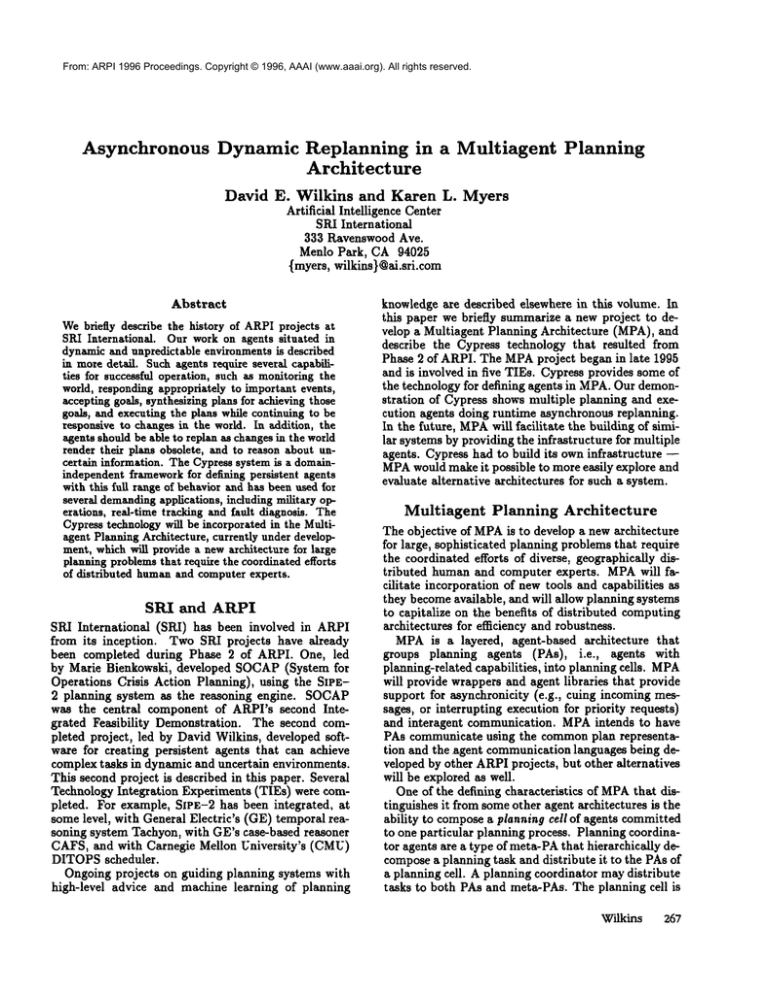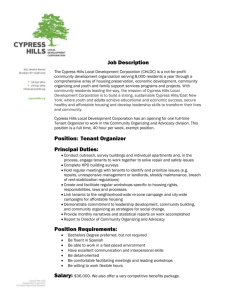
From: ARPI 1996 Proceedings. Copyright © 1996, AAAI (www.aaai.org). All rights reserved.
Asynchronous Dynamic Replanning in a Multiagent
Architecture
David E. Wilkins
Planning
and Karen L. Myers
Artificial Intelligence Center
SRI International
333 Ravenswood Ave.
Menlo Park, CA 94025
{myers, wilkins}@al.sri.com
Abstract
We briefly
describe
thehistory
of ARPIprojects
at
SRIInternational.
Ourworkon agentssituated
in
dynamic
andunpredictable
environments
is described
in more detail. Such agents require several capabilities for successful operation, such as monitoringthe
world, responding appropriately to important events,
accepting goals, synthesizing plans for achievingthose
goals, and executing the plans while continuing to be
responsive
to changes
in theworld.
In addition,
the
agents
should
beabletoreplan
aschanges
intheworld
render
theirplansobsolete,
andtoreason
aboutuncertain
information.
TheCypress
system
isa domainindependent
framework
fordefining
persistent
agents
withthisfullrange
ofbehavior
andhasbeenusedfor
several
demanding
applications,
including
military
operations,
real-time
tracking
andfaultdiagnosis.
The
Cypress
technology
willbeincorporated
intheMultiagent
Planning
Architecture,
currently
under
development,
whichwillprovide
a newarchitecture
£orlarge
planning
problems
thatrequire
thecoordinated
efforts
of distributed
humanandcomputer
experts.
knowledge
aredescribed
elsewhere
in thisvolume.
In
thispaperwe briefly
summarize
a newproject
to developa Multiagent
Planning
Architecture
(MPA),and
describethe Cypresstechnology
thatresulted
from
Phase2 of ARPI.TheMPA project
beganin late1995
andis involved
in fiveTIEs.Cypress
provides
someof
thetechnology
fordefining
agentsin MPA.Ourdemonstration
of Cypressshowsnmltiple
planning
andexecutionagentsdoingruntime
asynchronous
replanning.
Inthefuture,
MPAwillfacilitate
thebuilding
ofsimilarsystems
by providing
theinfrastructure
formultiple
agents.
Cypress
hadto builditsowninfrastructure
MPAwouldmakeit possible
to moreeasilyexplore
and
evaluate alternative architectures for such a system.
Multiagent
Planning
Architecture
The objective of MPAis to develop a new architecture
for large, sophisticated planning problems that require
the coordinated efforts of diverse: geographically distributed human and computer experts. MPAwill facilitate incorporation of new tools and capabilities as
they becomeavailable, and will allow planning systems
SRI and ARPI
to capitalize on the benefits of distributed computing
architectures for efficiency and robustness.
SRI International
(SRI)has beeninvolvedin ARPI
fromits inception.
Two SRI projectshavealready
MPAis a layered, agent-based architecture that
been completedduringPhase2 of ARPI.One, led
groups planning agents (PAs), i.e.,
agents with
planning-related capabilities, into planning cells. MPA
by MarieBienkowski,
developedSOCAP(Systemfor
Operations
CrisisActionPlanning),
usingthe SIPEwill provide wrappers and agent libraries that provide
support for asynchronicity (e.g., cuing incoming mes2 planningsystemas the reasoningengine.SOCAP
was the centralcomponentof ARPrssecondIntesages, or interrupting execution for priority requests)
gratedFeasibility
Demonstration.
The secondcomand interagent communication. MPAintends to have
pletedproject,
ledby DavidWilkins,
developed
softPAs communicate using the commonplan representawareforcreating
persistent
agentsthatcanachieve
tion and the agent communication languages being decomplex
tasksin dynamic
anduncertain
environments. veloped by other ARPIprojects, but other alternatives
will be explored as well.
Thissecond
project
is described
in thispaper.Several
Technology
Integration
Experiments
(TIEs)werecomOne of the defining characteristics of MPAthat displeted.Forexample,
SIPv.-2
has beenintegrated,
at
tinguishes it from someother agent architectures is the
somelevel,withGeneral
Electric’s
(GE)temporal
reaability to composea planning cell of agents committed
soningsystemTachyon..
withGE’scase-based
reasoner
to one particular planning process. Planning coordinaCAFS,and withCarnegieMellonUniversity’s
(CMU)
tor agents are a type of meta-PAthat hierarchically deDITOPSscheduler.
composea planning task and distribute it to the PAs of
Ongoingprojects
on guidingplanning
systemswith
a planning cell. A planning coordinator maydistribute
high-level
adviceand machinelearningof planning
tasks to both PAs and meta-PAs. The planning cell is
Wilkins
267
From: ARPI 1996 Proceedings. Copyright © 1996, AAAI (www.aaai.org). All rights reserved.
the closure of all PAs registered by the planning coordinator and any meta-PAs it invokes. Different planning
coordinator agents will compose their own planning
cells that instantiate their ownplanning approach and
algorithms. For example, a mixed-initiative
meta-PA
may include human agents in its cell. One meta-PA
might loosely couple planning and scheduling, while
another might tightly couple them.
Composinga planning cell will involve establishing
communication with the specified agents, where these
agents are committed to this particular planning process. As MPAexpands to include different technologies with similar or overlapping capabilities, it will be
desirable to compose a planning cell by broadcasting
for agents to provide particular capabilities. The question then arises of how to maintain and communicate
the current plan state within a planning cell. Our architecture accomplishes this by having a Plan Server
agent in each planning cell. A Plan Server maintains
all data structures associated with the evolving plan,
and answers queries about the plan.
One primary goal of MPAis to develop a set of
agents having common,well-defined, uniform interface
specifications, so we can explore ways of reconfiguring, reimplementing, and adding new capabilities to
the planning system, as well as exploring alternative
strategies for integrating planning and scheduling. In
particular, we will decompose an ARPIplanning system and an ARPI scheduling system into component
modules, where each component becomes its own PA.
This decomposition will allow different ARPItechnologies to be more tightly and flexibly integrated, using
meta-PAs to define different control strategies among
the PAs that represent componentsof the original technologies.
To better understand the capabilities our architecture ought to support, we surveyed the software tools
and products that are available or under development
by ARPIresearchers. The results of this survey will
help make MPAbe of as much use as possible to the
broader ARPIcommunity, and identifies technologies
that are sufficiently far along in their developmentto
be considered for inclusion as PAs.
Taskable,
Reactive
Agents
Our Phase 2 research concerned developing persistent
agents that can achieve complex tasks in dynamic and
uncertain environments. Werefer to such agents as
taskable, reactive agents. An agent of this type requires
a number of capabilities. The ability to execute complex tasks necessitates the use of strategic plans that
provide an outline for accomplishing tasks; hence, the
agent must be able to synthesize new plans at runtime.
The dynamic nature of the environment requires that
the agent be able to deal with unpredictable changes
in its world. As such, agents must be able to react to
unanticipated events by taking appropriate actions in
a timely manner, while continuing activities that sup268
ARPI
port current goals. The unpredictability of the world
could lead to failure of plans generated for individual
tasks. Thus, agents must have the ability to recover
from failures by adapting their activities to the new
situation, or even replanning should the world change
sufficiently. Finally, the agent should be able to perform all of these operations even in the face of uncertainty about the world state.
The notion of a taskable, reactive agent does not
correspond to a PA, but rather is an abstract description of the capabilities of a type of high-level agent. In
the MPA,such an agent would be implemented as a
meta-PAthat controlled several different PAs.
Manydomains of interest require agents with the capabilities we have described. Military operations provide a good example. Certainly, one would not engage in an undertaking such as Desert Storm without
first formulating a strategic mission plan. Reactive response and failure recover)" are necessary because unexpected equipment failures, weather conditions, and
enemy actions (among others) may require changes
the overall strategic plan. Reasoning in the face of
uncertainty is critical, since complete knowledgefor a
given scenario is unlikely.
Cypress provides a framework in which to create
taskable, reactive agents. Several features distinguish
our approach: (1) the generation and execution of complex plans with parallel actions, (2) the integration
goal-driven and event-driven activities during execution, (3) the use of evidential reasoning for dealing
with uncertainty, and (4) the use of asynchronous replanning to handle runtime execution problems.
Asynchronous replanning contrasts
with synchronous replanning, in which plan execution is halted
while an alternative plan is generated. Asynchronous
replanning is critical in domainssuch as military operations or robot control, whereit is infeasible to halt all
execution activities while replanning some portion of
the overall plan. Cypress is the first systemof whichwe
are aware that supports asynchronous runtime replanning with a general-purpose generative planner. When
problems arise during execution of strategic plans, Cypress can invoke a planning agent to produce a new
plan while an execution agent continues to execute unaffected portions of the plan. This multiagent replanning/execution architecture will eventually operate in
MPA,and lessons learned in its development will be
incorporated into MPA.
The motivation for Cypress was to build a heuristically adequate system that would be useful in practical
applications. To this end, Cypress relies on mature,
powerful planning and execution technologies, namely
the SIPE-2 generative planner, the PRS-CLexecution
system, and the Gister-CL system for reasoning about
uncertainty. 1 Wehave applied Cypress to a number
1In particulax, Cypress -- SIPE + PRS. Sipe-2, PRSCL, Gister-CL, Act-Editor and Cypress are trademarks of
SS.I International.
From: ARPI 1996 Proceedings. Copyright © 1996, AAAI (www.aaai.org). All rights reserved.
Action
Library
Sensory
~orm
Figure 1: Cypress Abstract Agent Model
of demanding problems, including real-time tracking,
fault diagnosis, and military operations (Wilkins
Desimone 1994).
While there have been many efforts to develop the
componenttechnologies (planners, replanners, reactive
controllers, uncertain reasoners) required for the kind
of agent described here, and even to integrate some
of these technologies, we are unaware of any current
systems that provide the full functionality of Cypress.
This paper focuses on the integration of plan genera.
tion, execution, and replanning in Cypress. Detailed
technical discussions of the subsystems are provided in
other documents.
clude applying predefined executable procedures stored
in the action library, invoking the planner to produce
a new plan for achieving a goal, or requesting that
the planner modify a previous plan for which problems have developed during execution. The planner
should be capable of synthesizing sophisticated action
sequences that include parallel actions, conditional actions, and resource assignments.
The planner plans only to a certain level of detail,
with the executor taking that plan and expanding it
at runtime by applying appropriate library actions at
lower levels of abstraction. Planning to the lowest level
of detail is often undesirable because of the resultant
combinatorics of deep searches. Furthermore, it makes
sense to plan downonly to abstraction levels at which
actions can be reasoned about ahead of time. For example, it is undesirable to plan large military operations downto the most minute detail since manydecisions are conditioned on information that is not available until runtime. Rather, it is the responsibility of
the executor to further adapt the plan to the actual
state of the world during execution. Similarly, it is often undesirable for the execution system to respond to
high-level goals without a plan; for instance, a reactive system should not attempt to implement a Desert
Storm-sized operation by applying procedures blindly.
There is an additional benefit to having an executor that can take plans at varying levels of abstraction
and expand them at runtime, namely, it enables thc executor to begin taking actions toward meeting a goal
without having to wait for a completely finished plan.
The Cypress
System
Cypress constitutes a particular framework in which
Cypress Abstract Agent Model
to define taskable, reactive agents based on the model
We beginby presenting
an abstract
characterization presented in the previous section. The architecture of
ofourmodelfortaskable,
reactive
agents,
asshownin
Cypress is depicted in Figure 2.
FigureI. The modelcontainstwo maincomponents,
Cypress is built on top of several mature AI systems
an executor
and a planner.
Thetwocomponents
share
that have been tested in a number of real-world apa library
ofpossible
actions
thatthesystem
cantake.
plications. SIPS.-2 (System for Interactive Planning
Thelibrary
encompasses
a fullrangeof actionrepreand Execution) is a classical planning system capasentations,
including plans, planning operators, and ezble of generating plans hierarchically (Wilkins 1988).
ecutable procedures. (Together, these are called Acts
PRS-CL(the Procedural Reasoning System) is a reacin Cypress.) The executable procedures correspond
tive execution system that integrates goal-oriented and
to predefined standard operating procedures for satisevent-driven activity in a flexible, uniform framework
fying individual goals. These three classes of actions
(Georgeff & Ingrand 1988). The Gister-CL system imspan multiple levels of abstraction.
plements a suite of evidential reasoning techniques that
The relationship
of this agent model to MPAis
can be used during both planning and execution to anthat a taskable, reactive agent would be a meta‘PA
alyze uncertain information about the world and poscomposed of several PAs. For example, in the Cysible actions (Strat & Lowrance 1989). For example,
press demonstration described below, the planner is
Gister-CL can be used to reason about uncertain inforone agent in its ownprocess, while the executor is immation in order to choose amongmultiple planning opplemented as two agents, each with its own process.
erators for a goal by the planner, and to choose among
suitable procedures by the executor at runtime.
Theexecutor
is alwaysactive,
constantly
monitorPRS-CLand SIPg-2 cmploy their own internal repingtheworldforgoalsto be achieved
or eventsthat
resentations for plans and actions. For this reason.
require
immediate
action,
in accordwithitscurrent
beliefs
andgoals,
theexecutor
takes
actions
inresponse Cypress supports the use of an interlingua called t.he
ACTrepre.sentation (Wilkins &: Myers 1995) tha.t ento thesegoalsa,ldevents.
Appropriate
responses
inWilkins
269
From: ARPI 1996 Proceedings. Copyright © 1996, AAAI (www.aaai.org). All rights reserved.
SIPE-2
Generative Planning
Gister-CL
Evidential Reasoning
Plangeneration
Fully automated
or mixedinitiative
Replunning
Asychronous
planrepair
#
Decisionsbasedupon
uncertainInformation
Procedure selection ~
Objectselection
Situationassessment
\
/
/
Act Library
I!
’ I
~-:
.tl, EST
ffmRf
IIMt)~ ACT2
I
PRS-CL
"CU~IEVlE
Plan Execution
f
Planexecution
Highandlowlevel
execution
with
reactive
empolyment
of
SOPs
Errorrecovery
Reactive
repairs
andasychronous
replanning
requests
[-
~~
J~
~_._
~
Int~r~Pzt
Io~AC,T)I
(~~
-t @J
representation
Planningoperators
Reactivestandard
operating
procedures
(SOPs)
Generated
plans
~
ables these two systems to share information.
ACT
provides a language for specifying actions and plans for
both planners and executors. Cypress includes translators that can automatically
map Acts onto SJPE-2
and PRS-CL structures,
along with a translator
that
can map SIPV.--2 operators aald plans into Acts. Using
the ACT interlingua,
PRS-CL can execute plans produced by SIPz-2 and can invoke Swig-2 in situations
where runtime replanning is required.
The Act-Editor
was implemented as a subsystem of
Cypress. The Act-Editor is a graphical knowledge editor for creating, displaying, and manipulating Acts. It
provides knowledge-editing capabilities
fox’ both SIP~2 and PRS-Ct,.
In contrast to many other agent architectures,
planning and execution operate asynchronously in Cypress,
in a loosely coupled fashion. This approach makes it
possible for the two systcms to run in parallel,
even
on different machines, without interfering with the actions of each other. In particular, PRS-C.L remains responsive to its environmcut during plan synthesis. The
subsystems of Cypress can function independently of
each. However, Cypress is used most advantttgeously
a.s an integrated planning framework that supports a
wide range of planning and execution activities.
ARPI
.....
[" ~r[~Comnmn
procedural
Figure 2: The Architecture
270
tal
ActEditor
of Cypress
PRS
PRS-CLis a frameworkfor constructing
persistent,
real-time
controllers
thatperformcomplextasksin dynamiccnvironments
whileresponding
in a timelyfashion to unexpectedevents.PRS-CL has proven uscful
in developing
scvcraldemanding
applications
that requircdintegration
of reactive
and goal-oriented
bchavior. including
tt monitoring
and controlsystemfor the
Reaction Control System of thc NASA Space Shuttle (.,eorgeff& Ingrand1988) and a controlsystem
for naval battle managemcntaboard a Grumman E2C ([ngrand.Goldberg,& Lce 1989).
Individual instantiations
of a Pits-cb system are referred to a.s PRS application agents. A PRS-C’t. applic;~tion agent consists of a dal.ab~se containing current
beliefs or facts about, th,~ world, a set. of current goals,
a set of procedures describing how sequcnces of actions
and tests may be performed to achieve certain goMs or
to rca.ct to p,’trticuh~r situations, and inlenfions that
keep track of the current proccdures being executed
by the agent. Muhiple PIKq agents can be active simult~uwously. Each PRS agent has its own local goals,
intentions,
and dal, abase and runsasyl=chroJmusly in
the overall framework.
A PRs-cI, agent int.pr~wls
with its environment
From: ARPI 1996 Proceedings. Copyright © 1996, AAAI (www.aaai.org). All rights reserved.
through
itsdatabase
(which
acquires
newbeliefs
in responseto changes
in theenvironment)
andthrough
the
actions
thatitperforms
asitcarries
outitsintentions.
Whilethe systemis running,
it constantly
monitors
incoming
information
andgoals.Activity
is triggered
in response
to theadoption
of an explicit
goalor to
somechangein theworld.Thiscombination
of goalanddata-driven
activity
yields
a flexible,
adaptive
plan
execution
framework.
In particular,
anyintention
can
be interrupted
andreconsidered
in thelightof newinformationaboutthe world.The monitoring
method
usedguarantees
thatanynewfactor goalisnoticed
in
a boundedtime,thusproviding
rapidresponse
to new
events.
PRS-CL
hastheproperties
necessary
fortheexecutor
component
of taskable
reactive
agents:
it is reactive,
integrates
goal-driven
andevent-driven
activities
uniformly,
andhasproveneffective
in numerous
applications.Theability
to definemultiple
PRSagentssupportsthesimultaneous
useof multiple
instantiations
of ourabstract
agentmodel.
SIPE-2
SIPE-2
is a partial-order
AI planning
system
thatsupportsplanning
at multiple
levelsof abstraction.
It
hasthe properties
required
by our agentmodel,including
theability
to generate
actionsequences
that
include
parallel
actions,
conditional
actions,
andresourceassignments,
and theabilityto performtemporalreasoning.SIPE-2can alsobe used to modifypreviously
generated
plans,an essential
capability for runtimereplanning.
In contrastto mostAI
planning
research,
heuristic
adequacy
hasbeenoneof
the primarygoalsin the designof SIPE-2.Example
applications
include
planning
theactions
of a mobile
robot,planning
themovement
of aircraft
on a carrier
deck,travelplanning,
construction
tasks,theproblem of producing
products
fromrawmaterials
on processlines,
andjointmilitary
operations
(Wilkins
1990;
Wilkins& Desimone1994).
Gister
Gister-CL implements a suite of evidential reasoning techniques that can be used during plan generation and plan execution to analyze uncertain information about the world and possible actions (Strat
Lowrance1989).The techniques
are baseduponthe
mathematics
of belieffunctions
developed
by DempsterandShaferandhavebeensuccessfully
applied
to
a variety
of problem
domains.
Gister-CL
supports
the
construction,
modification,
andinterrogation
of evidential
structures,
therebyallowing
a domainexpert
to quicklyandflexibly
develop
an argument
(i.e.,
lineofreasoning)
specific
to a given
situation.
The ACT Language
ACT was developed
as a domain-independent
language
forrepresenting
thekindsof knowledge
aboutactivity
usedby bothplanners
andexecutors.
A fullpresentationof the ACTlanguage
canbe foundin (Wilkins
Myers1995).Here,we summarize
someof the issues
thatmotivated
thedesignof ACT.
Planners
andexecutors
sharemanyrepresentational
requirements.
Bothrequirea language
forexpressing
goals,a meansof ordering
activities,
andmechanisms
forencoding
information
aboutwhena particular
procedurecan be applied.
Concepts
suchas protection
intervals
andresources
areuseful
forbothtypesofsystems.Nevertheless,
thereareimportant
representational
differences
forthetwoclasses
ofsystems
dueto
theirdifferent
functionalities.
Theplanner
is looking
aheadto thefuture
consequences
of courses
of action,
whiletheexecutor
is sensing
theworldandresponding
to incoming
information
andgoals.Thesedifferences
affect
action
representation
in several
ways.Forexample,execution
systems
frequently
useconditionals
and
loops,andmustprovide
themeansto express
reactive
behaviors
foroperating
on theworld.Generative
plannersstress
subgoaling,
parallel
actions,
andreasoning
to predict
theresultof takingcertain
actions.
The
ACTlanguage
is sufficiently
expressive
to support
all
of theseconcepts.
The development
of the ACT languageis similar
in motivation
to the KRSLlanguage(Lehrer1993).
In fact,theACT formalism
hasbeenone of theformalisms
driving
thedesign
ofthespecification
forplans
in KRSL.The KRSL effortis very ambitious,
trying to developa commonlanguagefor many types
of systems,
including
systems
forplanning,
execution,
scheduling,
simulation,
temporal
reasoning,
database
management,
and othertasks.In contrast,
the ACT
formalism
is focused
morenarrowly
on a commonlanguagefor planningand execution
systems.We view
thisnarrowfocusas critical
to achieving
success
in
near-term
usein software
tools,sincea commonrepresentation
thattriesto covertoobroadanareafaces
manyseriousproblems
(Ginsberg
1991).
It is always difficult to evaluate the merit of a representation language. However, we believe that the
design of the ACTformalism has been validated by
its successful use in Cypress applications ranging from
military operations planning to real-time tracking and
faultdiagnosis.
The ACTformalism
shouldbe viewed
as an evolving
entity
though,
whoseexpressiveness
will
undoubtedly
increase
in thefutureto supportadditional
applications.
Asynchronous Runtime Replanning
Cypresscontainsa domain-independent
runtimereplanningcapability,
whichallowsPRS-CLto invoke
SIPE-2to perform
replanning
forfailures
thatcannot
be remediated
locally
by theapplication
of predefined
Acts.The replanning
framework
supports
the followingbehavior:
1. PRS-CLdetects
an irrecoverable
failure
duringplan
execution.
Wilkins
271
From: ARPI 1996 Proceedings. Copyright © 1996, AAAI (www.aaai.org). All rights reserved.
2. PRS-CLcommunicatesthe current state of execution
to SIPE-2, and then continues executing those parts
of the plan that are unaffected by the failure.
3. SIPE-2 invokes its replanner to produce an alternative plan.
4. The new plan is translated to an Act and forwarded
to PRS-CL.
5. PRS-CLmerges the new plan with its current activities and continues execution.
Step 2 highlights an important characteristic of our
replanning framework, namely, its asynchronous mode
of operation. For asynchronous replanning, plan execution continues on those branches of the plan that
are not affected by the failure. This mode of operation contrasts with synchronous replanning, in which
plan execution is halted while an alternative plan is
generated. Asynchronous replanning presents greater
technical challenges, the most critical of which is to
reconcile the state to which plan execution has progressed during generation of a new plan with the new
plan itself. Asynchronousreplanning is critical in many
domains, since it is infeasible to halt execution while
replanning occurs for someparts of the plan.
Replanning
Architecture
Our basic model for replanning is bottom-up in nature,
being driven by the activities of the executor. The executor is responsible for recognizing replannable failure
situations, requesting new plans from the planner, and
finally implementing the new plan.
Wedeveloped a transformational approach to replanning where the activities in the original plan are left
unmodified when possible. In particular, the planner
modifies the failed plan during replanning rather than
generating a completely new plan, and the executor
continues execution of original-plan threads that are
unaffected by the failure while replanning takes place.
This approach contrasts with many existing methods
that simply abort execution of the old plan upon failure, and then begin execution of a new plan. The
transformational approach has the advantage of preserving undisturbed those activities in progress that
remain part of the new plan. This property is essential
in domainswhere it is infeasible to halt all execution
activities while replanning a portion of the overall plan.
An application PRS agent initiates the replanning
process upon detection of a failure that it recognizes
as replannable (Wilkins et al. 1995). All requests
for replanning are forwarded to a PRS agent named
Replannerthat performs all necessary communication with SxPE-2, thus enabling the agent that requested replanning to continue execution of those parts
of the plan that are unaffected by this failure. The
Replanner
agent is identical to other PRSagents: its
specialized behavior results from the specific set of Acts
that it executes. The architecture for the replanning
frameworkis depicted in Figure 3.
272
ARPI
The message sent to the Replanaer
agent indicates
the name of the application agent requesting the replanning, a unique identifier for this particular failure
episode, the plan being executed, the failed goal, and
the execution front. The execution front is a list of the
nodes last successfully executed on each parallel thread
of the plan. The Repla.nner agent also sends SIPE-2
relevant information from its database that characterizes the current world state. Without such updates,
SIPE-2could generate plans only for the original state
rather than the state in which the failure occurred,
since it does not monitor the world during execution.
The Repla,~er agent then awaits a response. In general, SIPE-2 will reply with a new plan that addresses
the failure. The new plan is forwarded to the PRS
agent that requested the replanning, which then integrates it with its current activities. If no newplan can
be generated for the overall goal, the Replanner notifies the requesting PRSagent., which in turn terminates
its execution of the original plan.
Whenissued a replanning request, SIPE-2 responds
by trying to modify the failed plan rather than producing a new plan from scratch. Doing so is often
more efficient, since only limited changes are generally
needed to fix the original plan. SIPE-2 begins by simulating the original plan through the execution front,
and then comparing its expected world state with the
actual state provided by PRS-CL.SIPE-2 collects those
formulae not expected to be true and determines how
they affect the failed plan. The plan is modified to
eliminate any problems by deleting unnecessary subplans and inserting new goals (as described in (Wilkins
1988)). The planner ensures that the future consequences of the newplan do not interfere with the stillactive execution threads.
One of the key technical difficulties in developing the
replanning capability was integrating the revised plan
with the current activities of the executor. This problem is further complicated for asynchronous planning,
since execution of the original plan continues while
the new plan is generated. To this end, SIPE-2 provides PRS-CLwith both a new plan and a node map.
The node map is a partial mapping from nodes in the
original plan that have been changed or removed to
nodes in the new plan. The node map encodes sufficient information for PRS-CLto transform its current
activities during transfer of control to the new plan.
Actions/subgoals being executed from nodes that are
not in the node map simply continue execution. For
mapped nodes, PRS-CLaborts their associated activities, and begins execution at the node in the new plan
specified by the node map. The transformational approach required the development of a number of complex routines for manipulating the runtime activities
of PRS-CL.
From: ARPI 1996 Proceedings. Copyright © 1996, AAAI (www.aaai.org). All rights reserved.
SIPE-2
PRS-CL
replan request with
plan name,world, failure
I updateworld14
I
via L~ILP, I
I problem
recognizer
I
~
I Replan agent
ISnht:
rrei’sl eeSlr~re
’
.. .
~
J
newplan.
node map
~_
~
.j.
Figure 3: Keplanning Architecture
Planning
under Uncertainty
Agents that operate in dynamic and unpredictable environments must be able to cope with uncertain information. There are several different sources of uncertainty. First of all, it is often impossibleto characterize
the current state of the world with complete accuracy.
Imperfections in the domain knowledge can compound
this situation, by adding inaccuracies to the expected
outcome of actions. As well, external events may alter
the world state in unanticipated ways.
There are several ways in which explicit reasoning
about uncertainty can be valuable for taskable, reactive agents, including initial situation assessment, Act
selection by both the planner and executor, Act parameterization, and plan evaluation. Wehave used GisterCL within Cypress to aid in Act parameterization and
plan evaluation (Wilkins d al. 1995). In particular, an
in-depth evidential analysis can be used to select particular military forces to carry out specific missions in
support of larger military objectives. Gister-CL could
also be applied to reasoning about the likelihood of success in applying Acts, although we have not yet made
use of that ability.
Cypress
Application
An implemented example illustrates the use of Cypress
within a military operations domain. This domain is
an extended version of the one used for ARPI’s second Integrated Feasibility
Demonstration. The domain knowledge includes approximately 100 plan operators, 500 objects with 15 to 20 properties per object,
and 2200 initial predicate instances. Plans range in
size from several dozen to 200 actions, usually spread
among numerous parallel threads of activity (Wilkins
& Desimone 1994}.
The scenario begins with a goal request for deterring
several military threats. SIeg-2 is invoked to produce
a plan using a set of Acts previously input to the system. During the planning process, Gister-CL is used
to assist SIPE-"2- in choosing appropriate military forces
for particular missions.
The plan produced by SIPg-2 contains four main
threads of parallel activities: two threads for deterrence using ground forces, one for deterrence using
naval forces, and the fourth using air forces. Throughout the planning process, a PRS-CLapplication agent
monitors the world for additional goals and events that
might require immediate action. The execution agent
executes the plan by applying appropriate Acts to refine the plan to lower levels of abstraction, eventually
bottoming out in actions that are executable in the
world. The execution agent remains responsive to new
goals and events throughout.
As part of the air deterrence operations, aircraft are
movedamongvarious air bases. The use of an air base
requires explicit transit approval, whichis granted initially for all bases in the domain. Anexecution failure
can be triggered by rescinding transit approval for any
of the bases used in the plan. The execution agent
records any such changes, and detects a failure when
execution reaches the stage where the rescinded approval is required. No Acts are defined for repairing
such a failure locally; thus, execution wouldcompletely
fail at this point without replanning. Whenreplanning is enabled, the execution agent will notify the
Replanner agent, which in turn will issue a replanning request to SIPg-2. Meanwhile, execution of the
remaining branches of the original plan continues without disruption.
Replanning for this situation produces a modified
plan in which an alternative mobilization strategy is
employed. One of our test cases results in the removal
of a dozen actio,s from the plan, replacing them with
a new subplan of similar length. The operations in
the new plan are selected so as not. to interfere with
the continuing execution of actions on other parallel
threads in the original plan. The new plan is sent to
the PRSapplication agent, which integrates the new
plan with its current activities and continues.
Conclusion
Cypress is a powerful framework in which to define
agents that must accomplish complex goals in dynamic
azld unpredictable environments. The application of
Wilkins
273
From: ARPI 1996 Proceedings. Copyright © 1996, AAAI (www.aaai.org). All rights reserved.
Cypress to the military operations domain attests to
the system’s usefulness.
The development of Cypress involved more than simply engineering the integration of existing systems.
Multiagent, asynchronous replanning constitutes one
important technological advancement, providing flexible plan execution that can adapt to significant unexpected changes in the world. In addition, interesting
technical problems had to be solved to bring the system into being. Of greatest significance was the design of the ACTlanguage as a commonrepresentation
for both executors and planners. In developing ACT,
subtle differences between these two classes of systems
arose. PRS-CLhad to be extended in numerous ways
to support the execution of plans produced by SIPF2: the kinds of knowledge employed in automatically
generated plans involved constructs not found in the
domain procedures defined for previous PRS-CLapplications.
Several characteristics
distinguish Cypress from
other systems that provide both planning and reactive execution. Many systems do not use generalpurpose planning and so cannot generate plans of sufficient complexity for manyapplication domains of interest. Previous work in runtime replanning has either
been limited to synchronous approaches (Laird 1990;
Washington & Ilayes-Roth 1992) or focuses on local,
adaptive modifications to rule sets., rather than employing the full look-ahead reasoning of a generative
planner (Lyons & Hendricks 1992; Firby 1987). The
ability to modify a complex, parallel plan at runtime
and adapt execution activity to the new plan is. to our
knowledge, a new accomplishment.
Finally, developing multiagent systems like Cypress
will be greatly facilitated by the results of the MPA
project. Cypress employed three agents in the demonstration described above. This required hardwiring
specific communicationprotocols into both the planner
and executor. There is no meta-PA in Cypress that
concisely documents the interaction of these agents.
Using MPA,the communication capabilities
would be
readily available in the form of a wrapper, and the overall architecture of the three agents wouldbe clearly defined in a meta-PA. The development, exploration and
evaluation of different agents and alternative agent architectures should be much easier with MPA.
Acknowledgments
Except for the first two sections, most of this paper was
previously published as part of "Planning and Reacting in Uncertain and Dynamic Environments" in the
Journal of Experimental and Theoretical AI, volume
7(l), 1995. pp. 197-227 (reprinted with permission).
The research described in this paper was supported
by the ARPA/RomeLaboratory Planning hfitiative
under Contracts F30602-90-C-0086 and F30602-95-C0235.
27.i
ARPI
References
Firby, R. J. 1987. An investigation into reactive planning in complex domains. In Proceedings of the 1987
National Conference on Artificial Intelligence, 202-206.
Georgeff, M. P., and Ingrand, F.F. 1988. Research on procedural reasoning systems. Final Report Phase 1, SRI International Artificial Intelligence
Center, Menlo Park, CA.
Ginsberg, M. L. 1991. Knowledgeinterchange format:
The KIF of death. AI Magazine 12(3):57-63.
Ingrand, F. F.; Goldberg, J.; and Lee, J. I). 1989.
SRI/GRUMMANCrew Members’ Associate
Program: Development of an authority manager. Final
Report SRI Project 7025, SRI International Artificial
Intelligence Center, Menlo Park, CA.
Laird, J. 1990. Integrating planning madexecution in
Soar. In Proceedings of the AAAI Spring Symposium
on Planning in Uncertain, Unpredicatable, or Changing Environments.
Lehrer, N. 1993. KRSLspecification language. Technical Report 2.0.2, ISX Corporation.
Lyons, D. M., and Hendricks, A. J. 1992. A practical approach to integrating reaction and deliberation.
In First International Conference on Artificial Intelhgence Planning Systems, 153-162. College Park,
Maryland: Morgan Kaufmann Publishers Inc., San
Mateo, CA.
Strat, T. M., and Lowrance, J. D. 1989. Explaining
evidential analyses. International Journal of Approximate Reasoning 3(4):299 353.
Washington, R. M., and Hayes-Roth, B. 1992. Practical real-tirne planning. Technical Report KSL-92-80..
KnowledgeSystems Laboratory, Stanford University.
Wilkins, D. E., and Desimone, R. V. 1994. Applying
an AI planner to military operations planning. In
Fox, M.. and Zweben,M., eds., Intelligent Scheduling.
Morgan Kaufmann Publishers Inc., San Mateo, CA.
685-709.
Wilkins, 1). E., and Myers. K. L. 1995. A common
knowledgerepresentation for plan generation and reactive execution. Journal of Logic and C.omputation
5(6):in press.
Wilkins, D. E.; Myers, K. L.; Lowrance, J. D.; and
Wesley, L. P. 1995. Planning and reacting in uncertain and dynamic environments. Journal of Experimental and Theoretical A1 7(1): 197-227.
Wilkins, D. E. 1988. Practical Planning: Extending
the Classical AI Planning Paradigm. Morgan Kaufmann Publishers Inc., San Mateo, CA.
Wilkins, D. E. 1990. Can AI planners solve practical
problems? Computational Intelligence 6(4):232--246.







